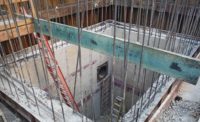Harrison/Dever Crib Complex Structural Renovations
Chicago
Best Project
Owner: Chicago Dept. of Water Management
General Contractor: F.H. Paschen
Lead Design Firm: Crawford, Murphy and Tilly Consulting Engineers
Structural Engineer: Globetrotters Engineering Corp.
Located in Lake Michigan, the Harrison and Dever crib complex is a long-standing landmark of Chicago infrastructure that continues to serve as a critical intake for the city’s fresh water supply. But performing necessary renovations on structures that are located 2.5 miles offshore presented significant challenges for engineers and contractors.
The William E. Dever Crib, built in 1935, provides water to the city by pumping it through a 20-ft-dia tunnel that runs 200 ft below the lake’s surface. The Carter H. Harrison Crib, which is linked to the Dever crib by a structural steel bridge, was built in 1900 and deactivated in 1998. Work on the Harrison crib included removal and replacement of deteriorated components. Dever Crib work included cleaning and painting interior steel; repairing steel checker plate flooring; repairing bulkhead seals; modifying steel framing; installing manual chain hoists; and conducting other repairs.
With virtually no available storage and staging space on site, up to 40 crew members, their tools and most equipment had to be transported each work day to the crib. “Overall, the project itself holds several individual challenges based on its location, but the true hurdle we had to clear was getting people out to the project site on a daily basis,” says Rick Winkler, project manager at F.H. Paschen.
Once on site, work space was extremely limited, so site coordination was critical for completing the job safely and efficiently. All crew members had remain constantly aware of their surroundings. “We were surrounded by water, so the majority of work involved working off a barge, lifts and swing stages,” Winkler adds.
As part of the project scope, exterior surfaces had to be cleaned and painted. A scaffold was designed and built around the crib because it was not possible to build a freestanding structure in the water. A vacuum was used at the bottom of the crib to collect falling paint before it entered Lake Michigan. Water levels differed each day, so the crib had to be painted three separate times for it to be completely finished.
In 8,363 worker-hours, the team saw no lost-time accidents and had no recordable incidents.
Small changes in weather could have a profound effect on the team’s ability to work on site. Wind speeds of 10 mph could result in 4-ft-high waves, which Winkler says would present unworkable conditions. “There were days I could sit in my office looking out the window and not see the flags move on the poles,” Winkler says. “But at the project site, they were experiencing 5-foot waves.”






Post a comment to this article
Report Abusive Comment